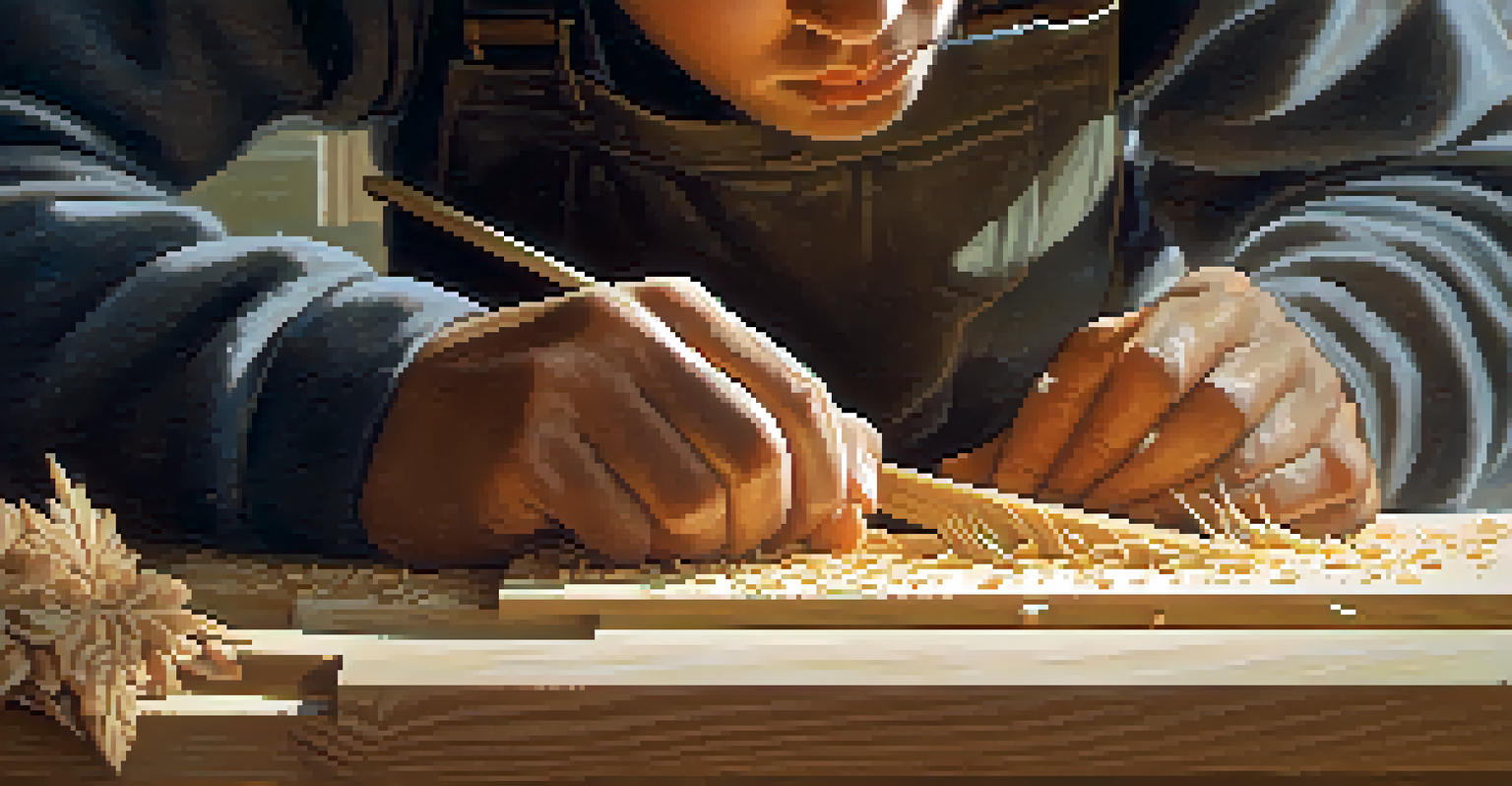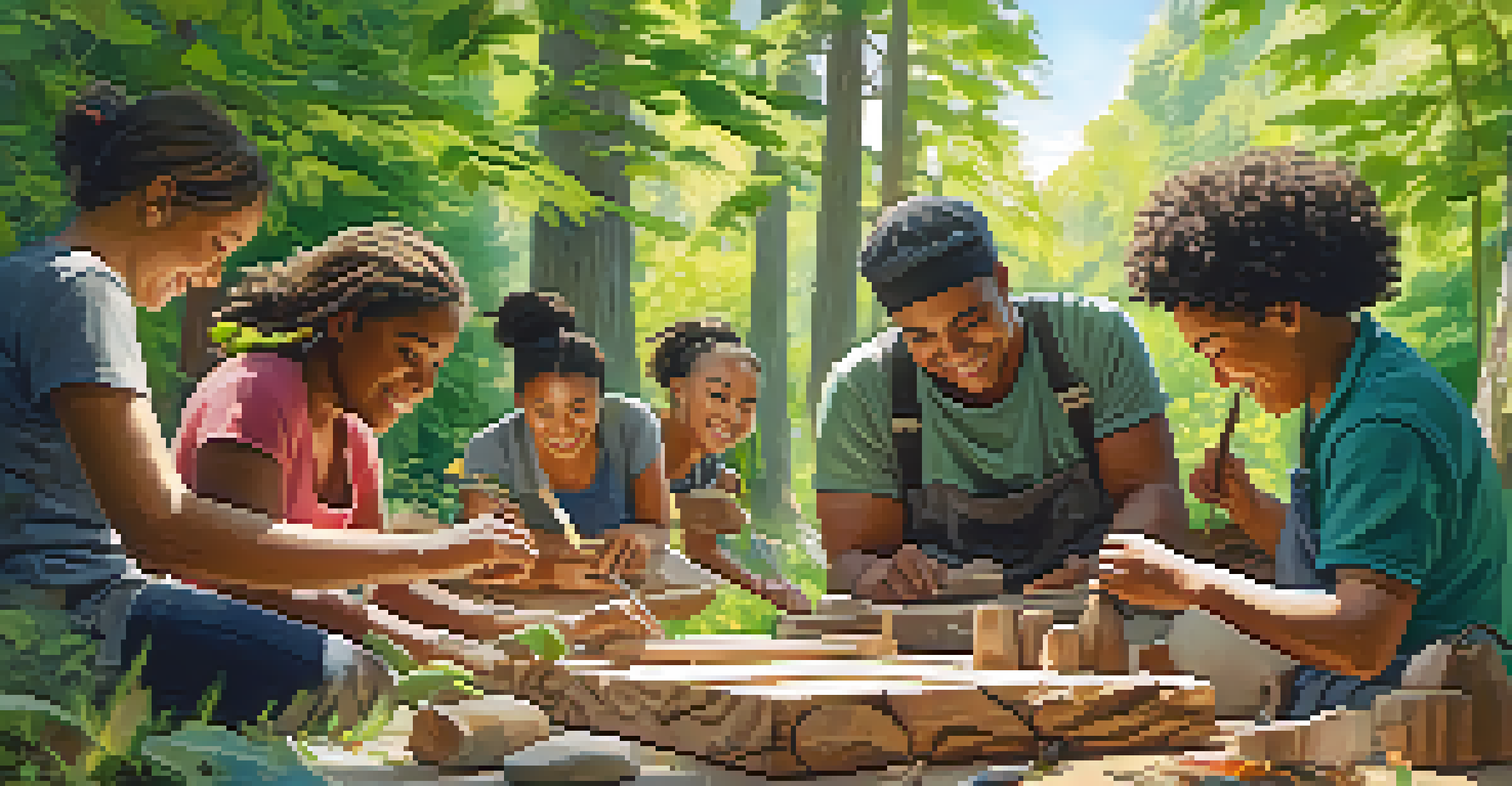Mindful Carving: A Journey into Meditation and Presence

What is Mindful Carving and Why It's Important
Mindful carving is an art form that merges creativity with presence, allowing individuals to engage deeply with their craft. This practice not only involves shaping wood or other materials but also invites practitioners to focus entirely on the moment, creating a meditative experience. By being present in the act of carving, one can cultivate a sense of mindfulness that transcends the workshop.
The quieter you become, the more you can hear.
In our fast-paced world, moments of stillness can feel rare. However, mindful carving provides a sanctuary where distractions fade, and the mind can settle. Just as meditation encourages one to focus on the breath, carving encourages attention to the material and the process, fostering a unique connection with both.
Ultimately, the importance of mindful carving lies in its ability to ground us. As we carve, we learn to appreciate each slice and curve, fostering patience and presence, which can be invaluable in everyday life.
The Benefits of Mindfulness in Carving
Engaging in mindful carving offers numerous benefits, both mental and emotional. For starters, it can reduce stress, as the rhythmic motion of carving can be soothing. By focusing on the task at hand, practitioners often find that their worries diminish, allowing for clarity and peace.

Moreover, mindfulness enhances creativity. When you're not preoccupied with external concerns, ideas can flow more freely. This creative freedom can lead to unexpected discoveries in your artwork, transforming a simple piece into something truly unique and personal.
Mindful Carving Fosters Presence
Engaging in mindful carving allows individuals to connect deeply with their craft, promoting a meditative experience that enhances focus and presence.
Lastly, carving mindfully encourages self-reflection. As you work, you might uncover thoughts and emotions that surface, providing an opportunity for introspection. This blend of creativity and self-awareness can lead to personal growth and a deeper understanding of oneself.
How to Begin Your Mindful Carving Journey
Starting your mindful carving journey can seem daunting, but it's simpler than you might think. Begin by gathering your tools and finding a quiet space where you won't be disturbed. This could be a workshop, a cozy corner of your home, or even outdoors, where nature can inspire you.
Creativity takes courage.
Next, set an intention for your carving session. This could be as simple as wanting to unwind or more specific, like exploring a new technique. Whatever your intention, allow it to guide your practice and keep you focused.
Finally, remember that there’s no right or wrong way to carve mindfully. Embrace the process, listen to your intuition, and allow your creativity to flow. The journey itself is what truly matters, not the end result.
Creating the Right Environment for Mindful Carving
Your environment plays a significant role in how mindful carving unfolds. A clutter-free, organized space can help minimize distractions and foster a sense of calm. Consider adding elements that resonate with you, such as soothing colors or inspiring artwork, to create an inviting atmosphere.
Lighting is also crucial. Natural light can enhance your mood and creativity, so try to position your workspace near a window. If that’s not possible, opt for warm, soft lighting that mimics daylight to keep your energy levels high.
Benefits of Mindfulness in Art
Practicing mindfulness while carving can reduce stress, enhance creativity, and encourage self-reflection, leading to personal growth.
Lastly, consider incorporating calming sounds. Some people find that soft music or nature sounds can enhance their focus, while others prefer silence. Experiment to find what works best for you, creating a sanctuary that encourages mindful creativity.
Techniques to Enhance Mindfulness While Carving
To deepen your mindfulness practice while carving, consider starting with breathing exercises. Before you pick up your tools, take a few moments to focus on your breath. Inhale deeply, hold for a moment, and exhale slowly. This simple practice can help center your mind and prepare you for carving.
Another technique is to carve with intention. Instead of rushing through each cut, take your time and really feel the wood beneath your tools. Notice the texture, the scent, and the way the material responds to your movements. This sensory awareness can enhance your connection to the process.
Finally, practice gratitude. As you carve, reflect on the materials you're using and the journey each piece has taken to reach you. Acknowledging this can cultivate appreciation, transforming your carving into a mindful ritual filled with meaning.
Mindful Carving as a Form of Meditation
Many people view meditation as sitting quietly with closed eyes, but mindful carving offers a dynamic alternative. This practice allows you to engage both your mind and body in a way that traditional meditation might not. By focusing on the act of carving, you can achieve a meditative state through movement and creativity.
The repetitive motions of carving can lead to a flow state, where time seems to disappear, and you're fully immersed in the moment. This experience can be incredibly calming, similar to the effects of deep meditation, but with the added joy of creating something tangible.
Creating a Calming Space
Establishing a clutter-free and inviting environment enhances the mindful carving experience, allowing for deeper focus and creativity.
Moreover, mindful carving can help you develop a greater awareness of your thoughts and emotions. As you carve, you may find that your mind wanders; recognizing this is a crucial part of the practice. Instead of judging yourself, gently bring your focus back to the carving, reinforcing the meditation aspect of your journey.
Connecting with a Community of Mindful Carvers
Engaging with a community of mindful carvers can enrich your practice and provide additional motivation. Local workshops or online forums can connect you with others who share your passion for carving and mindfulness. This sense of belonging can enhance your experience, offering support and inspiration.
Sharing your work and experiences with others can also deepen your understanding of the practice. You might discover new techniques, perspectives, or insights that you hadn’t considered before. This collaborative spirit can be incredibly rewarding.

Additionally, participating in community events, like carving demonstrations or exhibitions, can expose you to a variety of styles and methods. These experiences not only broaden your skill set but also affirm the idea that mindful carving is a journey best enjoyed together.